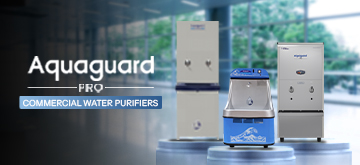
How to Troubleshoot Common Problems in Commercial Water Purifiers
PUBLISHED ON: 26-Oct-2025
Running a business or institution means depending on a steady supply of safe, clean water — whether it’s for drinking, cooking, healthcare, or manufacturing. To meet such high and consistent demand, most establishments rely on commercial water purifiers designed to deliver large volumes of purified water around the clock. However, like any high-capacity machine, a commercial water purifier can occasionally encounter issues. When flow slows, tastes change, or leaks appear, operations can grind to a halt and safety can be compromised.
The good news is that most issues have clear causes and simple fixes. Some can be handled in-house, while others require expert attention. That’s why our trained technicians handle the repairs so you can focus on your core work without worrying about water quality.
This blog explains common problems faced in commercial water purification systems, offers troubleshooting tips, and outlines when to seek expert assistance.
1. Low or No Water Flow
One of the most common complaints in a commercial RO water purifier is low or no water flow. This can lead to delays in kitchens, cafeterias, or production areas where large quantities of clean water are needed.
Possible Causes:
- Clogged pre-filters
- Low inlet water pressure
- Blocked RO membrane
- Pump malfunction
What You Can Do:
- Check the inlet water supply and pressure. If it’s low, the purifier cannot function properly.
- Inspect and clean pre-filters if accessible.
- Ensure the feed water valve is fully open.
When to Call a Professional:
If cleaning filters or checking pressure doesn’t solve the issue, there may be a pump or membrane problem.
2. Water Tastes or Smells Unusual
A commercial RO water purifier or a water cooler with a purifier should deliver clear, odour-free water. Unusual taste or odour is often an early sign of contamination.
Possible Causes:
- Expired or saturated activated carbon filter
- Biofilm or bacterial build-up in pipelines or tanks
- Contaminated storage tank
What You Can Do:
- Check if your carbon filter is due for replacement; these filters usually last long, depending on usage.
- Flush the purifier according to the manufacturer’s instructions.
When to Call a Professional:
Persistent bad taste or smell indicates deep contamination or bacterial growth. The technicians will sanitise tanks, replace filters, and restore your system to its original efficiency.
3. High Water Wastage
Many people are concerned about the water waste from their commercial RO water purifier. If you notice more wastewater than usual, the system might be under strain.
Possible Causes:
- Clogged or old RO membrane
- Incorrect system settings or pressure
- Old or malfunctioning flow restrictor
What You Can Do:
- Check if the RO membrane is due for replacement.
- Make sure the system hasn’t been tampered with or incorrectly adjusted.
When to Call a Professional:
If adjustments don’t reduce wastage, professional servicing can recalibrate the unit or install a water recovery solution to bring efficiency back up.
4. Leakage Around the Unit
Leaking water can damage floors, walls, and nearby equipment. Even small leaks can quickly escalate into expensive repairs.
Possible Causes:
- Loose pipe fittings or cracked tubing
- Damaged or worn-out seals
- Excessive pressure build-up inside the unit
What You Can Do:
Turn off the inlet valve immediately to prevent further leakage.
Wipe down the area and identify visible loose fittings if possible.
When to Call a Professional:
Leaks around the internal components should never be handled without training.
5. Frequent Filter Replacements
If your system demands new filters sooner than expected, it may be dealing with particularly poor feed water or high sediment levels.
Possible Causes:
- High turbidity in the incoming water
- Rust, silt, or industrial contaminants
- Inadequate pre-treatment
What You Can Do:
- Monitor your feed water quality regularly.
- Consider adding pre-filtration, such as sediment or iron removal, before water enters the main purifier.
When to Call a Professional:
The professional technicians can install or upgrade pre-treatment systems and advise on optimised filter schedules to reduce long-term costs.
Preventive Maintenance Is Important
Most of these problems stem from delayed maintenance. Regular servicing helps prevent costly breakdowns, extends equipment life, and ensures consistently safe water. This is especially important for high-capacity systems like the Aquaguard 250 LPH RO Plant Commercial Water Purifier, or combined solutions such as the Aquaguard Pro Thermapure 120 PSS RO ACH Commercial Water Purifier, which is a water cooler with purifier, and the Aquaguard Prima 50 B Commercial Water Purifier — a versatile commercial RO water purifier ideal for medium-demand settings.
Conclusion
Troubleshooting a commercial water purifier is not just about fixing immediate issues but about preventing them. By understanding common problems, taking simple in-house steps, and relying on professional support for complex issues, you can ensure continuous access to clean, safe water. Whether it’s a water cooler with a purifier, a high-capacity RO water plant, or a commercial RO water purifier, regular maintenance is your best defence against unexpected downtime and health risks.
Frequently Asked Questions
How often should filters be replaced in a commercial water purifier?
Filter replacement depends on usage and water quality. Typically, sediment and carbon filters last 6–12 months, while RO membranes last 2–3 years.
What’s the typical lifespan of a commercial RO water purifier?
With proper maintenance, a commercial RO water purifier can last 8–10 years or more. Regular servicing ensures parts are replaced on time and performance stays optimal.
Is professional maintenance worth the cost compared to self-servicing?
Yes. While basic troubleshooting can be done in-house, professional maintenance prevents major breakdowns, extends the unit’s lifespan, and often reduces total costs.
